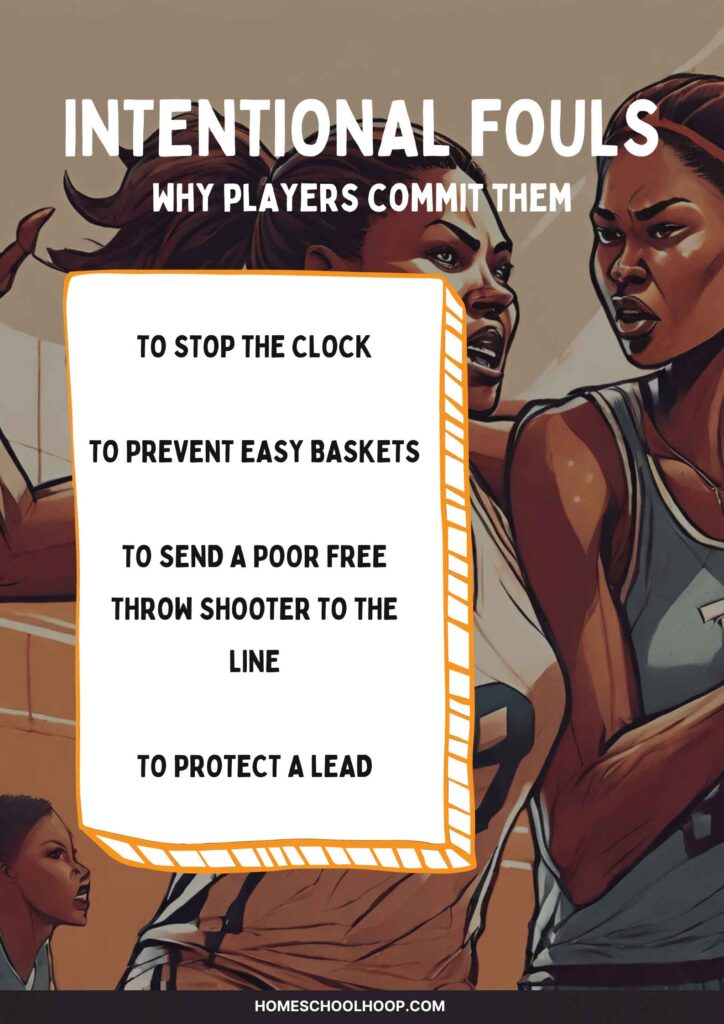Committing an international foul in basketball can be a clever move or a costly mistake. Often confused with flagrant fouls, an intentional foul is different in that a player fouls on purpose as a game strategy.
Key Takeaways:
- An intentional foul in basketball is a deliberate foul committed by a player to gain an advantage.
- Players commit intentional fouls to manage the game clock, prevent easy baskets, or sometimes out of frustration.
- Intentional fouls result in free throws for the fouled player and may include possession of the ball.
In this article, we’re going to explain intentional fouls in basketball. You’ll learn what they are, why players use them, and what can go wrong if they’re not committed correctly.
What Does Intentional Foul Mean in Basketball?
An intentional foul in basketball is when a player deliberately fouls another player. These fouls are done on purpose for team strategy, not meant to harm another player.

Teams use intentional fouls as a tactic. For example, if they’re losing and there’s not much time left, they might foul to stop the clock. Or, they might foul to stop an opponent who’s likely to score.
Intentional fouls are different from flagrant fouls, which are about unnecessarily rough play. They’re also different from technical fouls in basketball, which are related to unsportsmanlike conduct.
Intentional Vs. Unintentional Fouls
Unintentional fouls are accidents that happen during the game. For example, when players are caught in a bad defensive position and end up hand-checking, blocking, or committing a reach in foul.
Intentional fouls are calculated. The player who commits an intentional foul knows what they’re doing and why they’re doing it. They’re trying to create a specific outcome, like stopping the clock or sending a weaker free-throw shooter to the line.
Risks of Intentional Fouls
Intentional fouls are a common strategic fouling strategy, but they can be risky. The player committing the foul must go for the ball and not be unnecessarily blatant or aggressive. Otherwise, a referee can call a flagrant foul, which gives two free throws and the ball to the opponents.
Also, players in the NBA and WNBA cannot intentionally foul a player to prevent a fast break. Otherwise, they’ll be called for a transition take foul, which gives their opponents a free throw and the ball back.
The NBA and WNBA also have in place rules to prevent intentional fouling players on out-of-bounds players. Teams were starting to foul players before the ball was thrown in to force free throws before any time came off the clock. This is no longer allowed, and results in a free throw and the ball.
Why Do Players Commit Fouls on Purpose?
Players commit intentional fouls on purpose for various strategic reasons.
Remember this: when a player fouls, the game and clock stop. And if the other team is in the bonus, they get free throws. Sometimes, making this happen can help a team in certain situations.

Here are some strategic reasons for intentional fouling:
- To stop the clock: When time is running out, and a team is behind, they might foul to stop the clock and force free throws. This allows them to get the ball back and more time to catch up.
- To prevent easy baskets: If the other team has a clear path to score, say off a drive to the basket or through an offensive rebound, a foul can prevent the sure basket and force the player to earn their points at the free throw line.
- To send a poor free-throw shooter to the line: Occasionally, teams will foul a player who notoriously struggles with free throws (example: Hack-a-Shaq). With that player likely to miss both shots, the tactic almost guarantees possession loss.
- To protect a lead: When winning by three near the end of the game, a team may foul to force free throws. This means the other team can only score two points from free throws, not three from a basket.
Rules and Penalties for Intentional Fouls
Referees don’t upgrade all of these types of fouls to “intentional fouls.” In most cases, intentional fouls in basketball are treated as regular personal fouls.
However, referees can upgrade any common foul to an “intentional foul” if the fouler doesn’t make an honest play for the ball. The official signals an intentional foul by putting both arms above their head and crossing them in the shape of an “X.”

When referees do officially call an intentional foul, it results in at least one free throw and possession of the ball.
Also, some leagues have specific intentional foul rules.
NBA and WNBA Rules
The NBA and WNBA have unique rules meant to penalize teams more severely if they foul intentionally at certain points in the game.
- Any fouls committed in the final two minutes of each period (and overtime), regardless if they appear intentional, give the fouled team one free throw and ball possession.
- Any foul that occurs before an inbounds pass at any point in the game results in a free throw and ball possession for the other team.
- If an intentional foul is deemed excessive or not a legitimate play on the ball, it can be upgraded to a flagrant foul.
NCAA Rules
There is no intentional foul in NCAA Men’s Basketball, according to their rule book.
NCAA Women’s Basketball Rules
In NCAA Women’s Basketball, player-contact fouls can be upgraded to intentional fouls via referee judgment if the player who fouls:
- Fails to make a legitimate attempt on the ball
- Is trying to negate their opponent’s obvious advantageous position
- Make contact away from the ball against an opponent that isn’t involved in the play to try to stop the game clock
- Make contact with an opponent who is throwing the ball in
A unique aspect of intentional foul rules in NCAA women’s basketball is that they can also be called for excessive or unnecessary contact, or swinging an elbow.
Intentional fouls in NCAA women’s basketball result in two free throws, plus the ball.
Strategies for Using Intentional Fouls to An Advantage
Using intentional fouls wisely can help teams come from behind and limit opponent scoring opportunities. Here are a few basketball coaching tips and examples for using them effectively:
- Know the clock: Use intentional fouls when your team is down and your opponent is running down the clock. This can help you extend the game and give you the ball back quickly.
- Penalize poor shooters: Consider fouling players who are open for a shot but bad at free throws. This can be more beneficial than giving them a high-percentage field goal.
- Break opponents’ rhythm: This can backfire, but sometimes fouling a player on purpose can disrupt their momentum and give your team a chance to regroup.
An example of this is the Boston Celtics intentionally fouling Andre Drummond of the Chicago Bulls while up 32 points in the 4th quarter. Drummond is a notoriously poor free throw shooter, and the Celtics were looking for the largest point differential win to help their chances in the NBA In-Season Tournament.
Controversies of Intentional Fouls
Intentional fouls in basketball are commonly accepted game tactics, but they also spark debate about their sportsmanship and ethical implications.
Fans, in particular, can find them tedious because they slow down the game and disrupt the flow. How many times have the final few minutes of a game taken 20 minutes to get through?
The NBA and WNBA have taken steps to discourage excessive intentional fouling. Every league wants to keep the game pace exciting, so the game rules will continue to evolve.
FAQs
What are intentional fouls in basketball?
An intentional foul in basketball is when a player deliberately fouls another player for strategic reasons, like stopping the clock or preventing easy scores.
What is considered an intentional foul in basketball?
A foul is considered intentional when a player makes deliberate contact with another player. It’s usually done to stop the game or gain a strategic advantage.
How do referees judge intentional fouls?
Referees look for clear, deliberate contact made by a player. They check if the player made an actual effort to play the ball or just fouled the opponent directly. The referee’s judgment is based on whether the foul seemed planned and not a part of regular play.
How many free throws on an intentional foul?
In the NBA and WNBA, the player who was intentionally fouled gets a single free throw. Two free throws are awarded to an intentionally fouled player in NCAA women’s basketball.
What is a foul with no intention to make a play on the ball?
A foul with no intention to play the ball is when a player fouls another without trying to get the ball at all. It’s seen as intentional and can be penalized more strictly because it’s not a part of normal play.
Can intentional fouls change the outcome of a game?
Yes, intentional fouls can change the outcome of a game. They can stop the clock, change possession, or lead to free throws. These actions can affect the score and the game dynamics, sometimes leading to a shift in who wins or loses.


